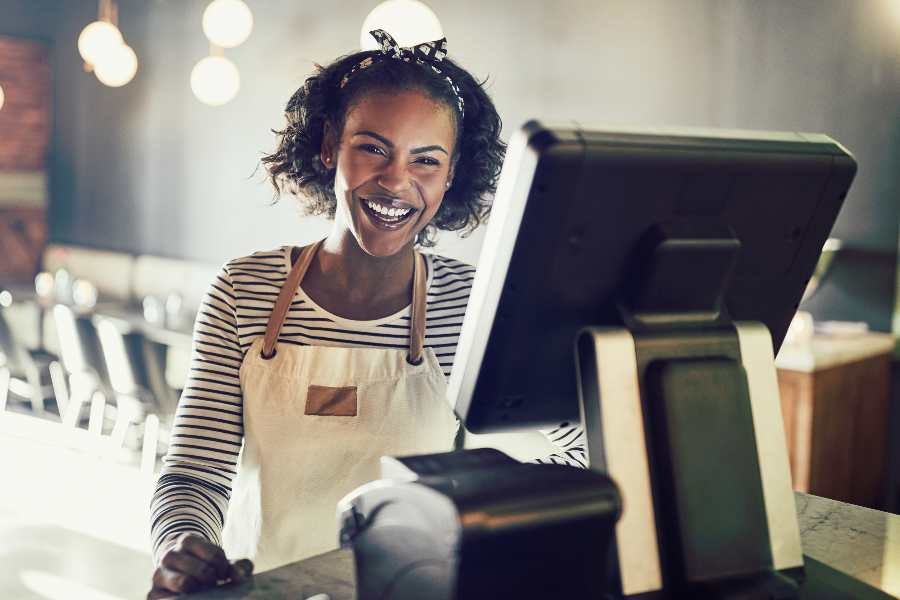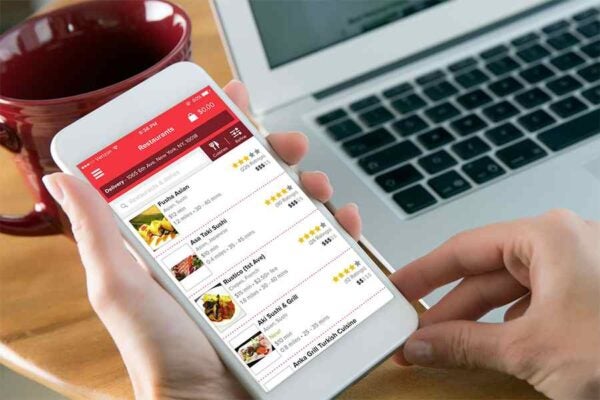A virtual restaurant brand, also known as a virtual kitchen, is a restaurant concept that operates solely via online ordering and delivery without a dedicated dine-in location. Virtual brands utilize existing kitchen spaces to cook their food and expand through a form of franchising, allowing partner restauranteurs to offer the virtual brand’s products through online platforms such as Uber Eats or DoorDash.
When considering working with a virtual brand, there are likely two scenarios for business owners. The first scenario is adding an existing virtual brand as an extension to your existing physical restaurant. The other scenario is starting your own digital-only food business from scratch.
Let’s discuss when adding a virtual brand makes sense and look at some current top virtual brands.
When to Add a Virtual Brand
While virtual brands can be very lucrative, creating or working with one needs to make sense for your business. Below is a quick review of when you should consider adding a virtual brand to your business portfolio.
Existing Restaurant
Adding a virtual brand may make sense for an existing restaurant if your sales are low, you are a seasonal kitchen, or you desire more revenue channels. For example, adding a virtual brand can be a great way to generate revenue and support expansion into your business’s second location. Due to how profitable a virtual restaurant can be, adding one to your existing location can be a great way to get more cash into the business while also growing your brand regionally.
Some restaurants thrive as the “ghost kitchen” for online virtual brands. Consider being a kitchen that produces orders for one or multiple brands for easy revenue without the effort of taking your own brand to market and sell to customers.
New Venture
A virtual brand is a great way to test concepts that you believe may have legs as a physical restaurant. Virtual restaurants are also a useful way to establish a food company in a region, making it easy to draw customers whenever you decide to open a physical restaurant. Due to how low-cost a virtual restaurant is, it is important to find an exciting core product that you can scale and build around. If you have this product and believe you can execute it at scale, then opening a virtual restaurant is a good decision.
Advantages of a Virtual Brand
Virtual brands existed before the pandemic, championed by UberEats and DoorDash, but exploded during the pandemic once the need for home-delivered meals became a necessity for the general consumer. It has since remained popular, with the many advantages that come with this business model.
We often saw a blend of virtual brands and physical locations for food businesses in 2024. Only 13.8% of virtual brands existed solely online, while 86.2% of restaurant virtual brands utilized both the online space and a physical space. The lack of solely virtual brands left room for food entrepreneurs to enter the space and create a niche. Below are the advantages you can expect to find from managing a virtual brand in 2025.
Low Startup Costs
Starting a virtual brand is not hard and can be done in various ways. Many restaurant concepts started as a virtual brand are often produced out of a shared kitchen space, an existing kitchen space, or a facility dedicated to online-only food production. These shared, often well-resourced spaces offer the ability to make food and other products with low costs for maintenance and rent. If you can find a facility that is reliable and makes sense for your business, then the costs for starting your brand will be much lower than starting a traditional restaurant.
The average startup costs for a ghost kitchen in 2024 ranged between $20,000 to $60,000. Compare this to starting a restaurant, where costs can range anywhere from $95,000 to $2,000,000, depending on various factors. Virtual restaurants are scrappy ways to establish your brand, test menu items, and get a feel for the potential success of a business you are trying to build. With lower costs, it can be a great entry point for newer business owners.
Growing Demand for Food Delivery
In 2024, 52% of American consumers saw takeout and delivery as an essential part of their lifestyle. Being a part of this market is a good choice, as the need and want for food delivery is only growing. Consumers want convenience, good value, and delicious food that is easy to access. Establishing a virtual restaurant brand that can meet these needs and surpass expectations can prove lucrative if done right.
Data from 2024 showed 67% percent of US consumers were looking for new meal and food options, opening the door for newer brands to be accepted in today’s current market. Virtual brands are easy to launch and are cheaper than restaurants, affording savvy food business owners the ability to launch multiple projects in a shorter amount of time. Capitalizing on the want for more options and routine adoption of food delivery is what gives virtual restaurant brands an advantage in 2025.
Scalability
It is infinitely easier to scale a food business that is not tied to a physical space or geographic region. One masterful example of the virtual kitchen concept is Guy Fieri’s Flavortown Kitchen virtual restaurant concept. The website for this brand touts an astonishing 170 locations across 34 states in which food can be ordered through a food delivery app. These “kitchens” are all producing food out of existing restaurants or ghost kitchen facilities. Simply put, the ability to scale to 170 locations with a physical space takes an enormous amount of investment and time. The same is not true for a virtual brand such as this.
Another example of the power of scaling a virtual brand is @Pizza. This online-only pizzeria utilizes pizza shops around the country to sell pies to customers daily. Clever marketing through Uber and social media accounts delivered a hungry and loyal customer base to the brand over the past few years, with over 200 locations currently operating. Scaling through existing restaurant infrastructure was key to the success of this virtual brand.
Data-driven Performance
One key example of why virtual brands may be easier to start than physical ones is the relatively comprehensive amount of data you get when you are only selling online. Virtual brand companies or platforms offer a large amount of in-depth data that can then be deployed to make better business decisions. Furthermore, third-party delivery apps also provide copious amounts of data from which you can derive feedback and learn more about your customer base.
All of the interactions that happen with a virtual brand take place through an online service or platform. Being able to trace comments on sales, track trends, and get high-level information with ease can be key when starting a restaurant concept. This detailed data can be the difference between allowing a brand to work or letting it fail. Optimizing your menu, marketing to targeted customer groups, and utilizing customer insights are all abundant options when managing a virtual restaurant.
Added Revenue and Reach
It is thought that business owners can make up to a 30% profit on virtual brands, which is an incredibly high profit margin compared to a traditional restaurant’s 3% to 5%. Virtual brands simply cost less to operate and can be very lucrative if popular and done right. Operators can pay up to 40% of sales to third-party virtual restaurants but still often receive up to 30% on profits due to limited labor costs and other additional overhead costs. The two big cost factors that operators need to worry about are food packaging costs and food costs, leaving a lot of room for profit to be attained.
A virtual brand can also expand the footprint of a restaurant. For example, your restaurant can be physically located in a part of a city, while the virtual brand can be offered throughout the whole city and even outside of it. Established physical restaurants can utilize ghost kitchens and other production facilities to grow their virtual brand, while also growing interest in their physical location. The added revenue channel of a virtual restaurant can also help expand and solidify a restaurant’s brand across a region.
Reduced Financial Risk & Quicker Time to Market
Due to lower startup costs and lower overhead costs, the risk of operating a virtual restaurant brand is very low financially. Without the need for front-of-house staff, labor costs are extremely low, which is a huge factor in a traditional restaurant. Furthermore, your virtual brand focuses only on food production, streamlining the labor you are utilizing to produce your products. With this in mind, it is much easier to try new restaurant concepts virtually rather than opening a physical location.
The time to market with virtual brands is also very small. This is very useful when testing new concepts, as the timeline to get customer feedback and buy-in is very short. Furthermore, being early to food trends or dining options can be an advantage and help cement a brand as the go-to authority for that type of food. With speed on your side, a virtual restaurant can help you be a first-mover on new and exciting food trends that customers are willing to spend money on.
Multiple Concepts
The last big advantage of virtual restaurants is the ability to run more than one concept out of any given space. Some companies and facilities only serve online meals but do so across a variety of different brands. Due to low startup costs and the centralized nature of food production for virtual brands, you can literally offer multiple different brands out of one ghost kitchen. This leads to more sales, different customer segments, and full utilization of the physical space you are using to operate your virtual brand.
Virtual Brand vs Ghost Kitchen
The terms “virtual brand/restaurant” and “ghost kitchen” are often used together, and it can be confusing to know what the term represents exactly. A virtual brand or restaurant is a business or section of a business that sells food online through delivery to customers. A ghost kitchen is a facility in which virtual restaurants or brands work out to produce products. If a virtual restaurant is a business, the ghost kitchen acts as the facility where the products are made.
Learn more about starting a ghost kitchen in our comprehensive guide.
Examples of Virtual Restaurants
There are a lot of different examples of virtual restaurants that are thriving in 2025. Due to how adopted online ordering has become for so many diners, virtual brands have grown to become a key part of the dining sector. Below is a look at some popular virtual restaurants that exist in 2025.
Buddy V’s Cake Slice
Buddy V’s Cake Slice is a virtual restaurant that delivers to 684 locations nationally. The brand is built off of the TV and Chef personality Buddy Valastro, and his highly popular “Cake Boss” show. This virtual restaurant specializes in artisanally made cake, offering cake slices of different varieties that can be mixed and matched. The brand capitalizes on the dessert aspect of online food delivery and has grown immensely since its inception.
The Meltdown
An interesting development that has come from the rise of virtual brands is the ability of large food companies to branch out into different revenue channels and brand types online. The Meltdown is one of two virtual restaurant brands that has been launched by Denny’s, the popular diner chain. This concept delivers “melts,” which are cheesy sandwiches with different components and flavors. Denny’s is known for American comfort food, and a sandwich melt and similar sandwich options are what this brand focuses on.
Moonbowls
Moonbowls is a gluten-free, Korean-inspired bowl concept. They offer both gluten-free and vegan options on their menu and focus on delicious Korean concepts for their dishes. Menu items include a Korean Hot Chicken Bowl, an Impossible Beef Bowl, and a Sesame Tofu Salad. Healthy, unique, and easy to make, this concept thrives on global flavors and easy packaging in a to-go bowl.
Dough Daddy’s
Dough Daddy’s is a pizza-focused virtual restaurant brand located in Chicago’s West Loop. They service the town and surrounding region through Uber Eats, and are known for their Detroit-style pizzas, in which sourdough starter is used in the dough. This virtual brand is interesting, as they are a virtual brand known for their high-quality product. While they may not be nationwide, they have a loyal customer base in their region that buys from them due to their excellent food quality. This high-quality, niche virtual brand has built a large customer base due to the exclusivity of online orders and a singular region.
Creators’ Kitchen
One virtual restaurant brand that takes the online space they are into the next level is Creators’ Kitchen. This virtual brand focuses on utilizing kitchen spaces across the country to deliver viral, trending food recipes on TikTok. Their website links out to viral recipe videos that they are offering to you through a food delivery platform. This brand will add items, such as the Baked Feta Pasta below, and credit creators that made the dish. This brand is an example of using the native online element of their business in a way that is current and attracts a larger audience.
How to Start a Virtual Brand
Starting a virtual brand is much easier than a traditional restaurant, but it does come with some planning and conceptualization. The purpose of starting a virtual brand is to feed a larger region of customers with delicious yet easy-to-make food items. That being said, there are certain steps you need to take in order to ensure your virtual restaurant is appealing and stands out amongst the heavy competition on online food delivery apps.
Step 1: Pick Your Concept
You will notice a trend in the different brands mentioned above. They mostly rely on selling one menu item which is varied in different options across their menu. Chicken wings, sandwich melts, and slices of cakes—all of these brands specialize in a certain menu item that can be repeated easily. Items such as dumplings, tacos, or even crispy chicken sandwiches are all common in the online restaurant space. If your product is niche, delicious, and exciting, then you are likely to build a following.
Step 2: Keep Your Menu Simple
When building the menu for your virtual brand, keep it simple. The beauty of a virtual restaurant is the low costs you have on staffing and overhead. If your menu is too complex, more staff will be required, or your food will be of poor quality. Keeping a concise, focused menu is key to ensuring success and quality food for your brand.
Step 3: Test Your Recipes
Before going live on an online delivery platform, you and your team should test your recipes to see how they taste after delivery. Making your products, packaging them, and then delivering them to another location will allow you to see what customers are going to experience when they order. Testing your recipes can help you make formulation changes, choose different packaging, or omit menu items due to poor quality upon delivery.
Step 4: Pick a Functional Space
Picking a ghost kitchen that is well-stocked, clean, and easy to use is the goal for your virtual restaurant. A ghost kitchen must be sanitary, have a good equipment flow, and must be conducive to delivering food. If the kitchen is too far from an exit, is not functional for staff, or is in a location that offers potential food risk, then choosing another place to prepare your product is key.
Step 5: Market Your Brand
Creating an online presence and ensuring customers see your brand is important, as this will drive sales for your restaurant. Without a physical location for customers to see, an online presence is key to ensuring you grow your business and obtain a solid customer base. With smart marketing, utilizing features through your third-party apps, and focusing on the image of your online brand, you can grow and become successful in a relatively short amount of time.
Check out more strategies and ideas in our guide to restaurant marketing.
Frequently Asked Questions (FAQs)
Virtual brands are still relatively new to the food industry, really gaining traction in 2020 during the pandemic. That being said, these business types are here to stay, and food entrepreneurs should know about them. Below are some frequently asked questions regarding virtual brands.
Last Bite
Adding a virtual brand is a good decision due to the relatively low cost and potential for higher profit margins this business type provides. If you have a concept that is focused, easily scalable, and delivers high-quality food, then offering a virtual restaurant may be your best bet when it comes to entering the food industry. Marketing and creating excitement around your brand is key, especially on online platforms that are saturated with different brands. That being said, with a great core product, you can have success with a virtual brand in 2025.
ALSO READ



